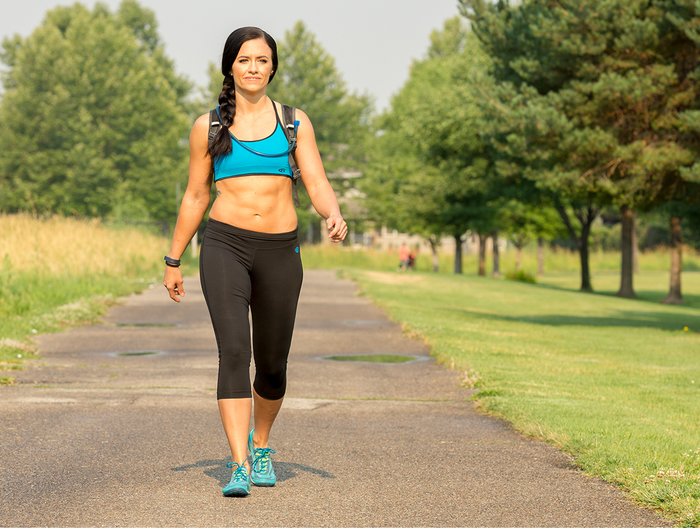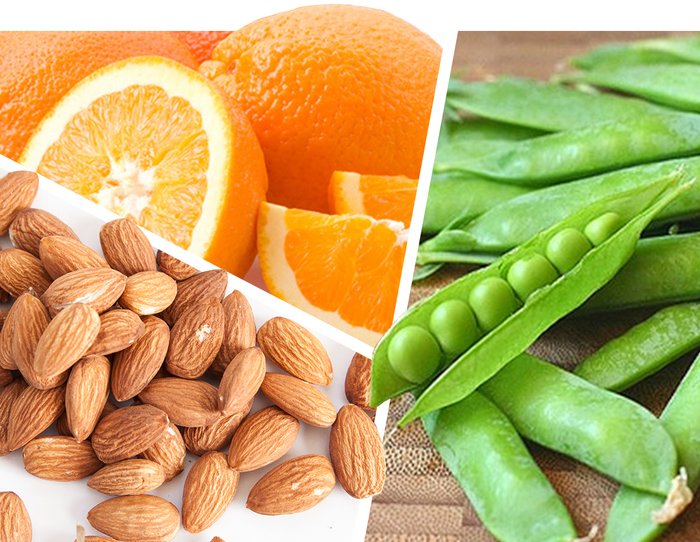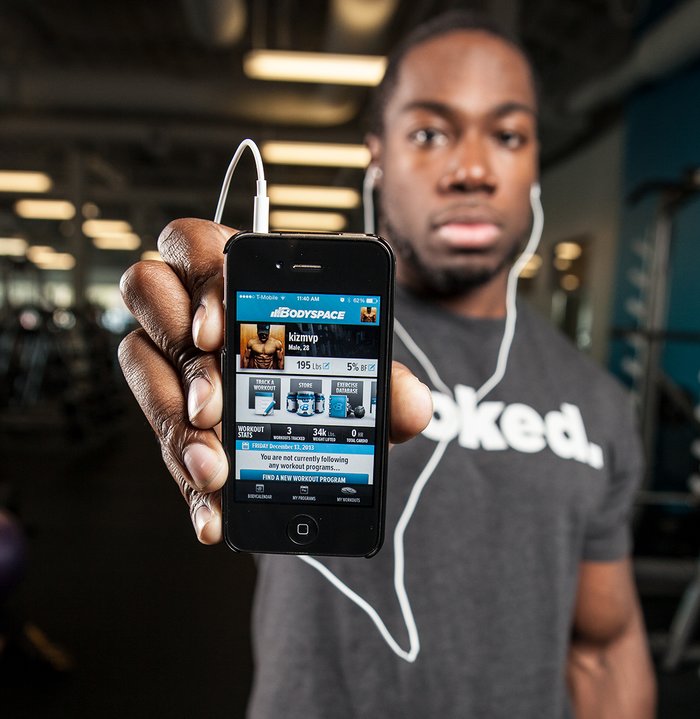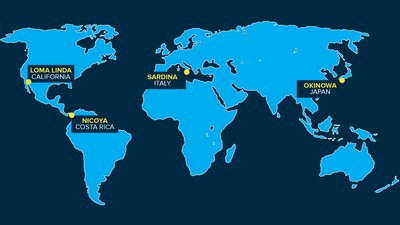In Icaria, Greece, one in three people live into their 90s.[1] And they're not the only ones making a mockery of Father Time. Other anti-aging hot spots—called "blue zones"— include Okinawa, Japan; Sardinia, Italy; Nicoya, Costa Rica; and Loma Linda, California, home to a large Seventh-day Adventist population.
Despite being geographically far apart and differing immensely in their eating and exercise habits, these locations share more in common than you think. In his New York Times best seller, "The Blue Zones Solution," Dan Buettner has identified traits and habits shared by these long-living folks. He calls them the "power nine":
- Moderate, regular physical activity
- Life purpose
- Stress reduction
- Moderate calorie intake
- Plant-based diet
- Moderate alcohol intake, especially wine
- Engagement in spirituality or religion
- Engagement in family life
- Engagement in social life
Although these common denominators encompass many areas of life, they each align well with your fitness pursuits, too. Apply the power nine to your health and fitness habits today to reap short-term and long-term rewards!
The Power 9 in the Fitness World
1. Move More
People from each of the blue zones spend a lot more time on their feet than their butts. This high level of activity results in a significant increase in the number of calories burned per day via nonexercise activity thermogenesis (NEAT), which is the number of calories burned through spontaneous movement and activity. Depending on your work and leisure activities, your NEAT may vary by up to 2,000 calories.[2] Imagine the impact this can have over several days, let alone several months!

Life Lesson: Find a way to move more during your day. Whether it's taking a walk outside to break up the work day or implementing a desk-bound yoga session for a few minutes each morning, find a way to move more.
Inquire about having your employer install a standing desk for you. A study published in the Journal of Internal Medicine reported an average increase of 700 calories per day when switching from a seated position to a standing position during the work day.[3] Given that sitting is often called "the new smoking," it's worth making a serious inquiry with the boss.
2. Find Your "Why"
The Okinawans call it "ikigai." The Nicoyans call it "plan de vida." In both instances, it translates to "why I wake up in the morning."
If you want to be successful, you need to know your "why." Why do you think Olympians and CEOs have achieved success? It's because they know their "why." This enables them to mindfully execute each part of their day with intent. Their short- and long-term goals align with their "why."
The rigors of dieting and training take a toll on everyone. But if you can take a step back and remember why you started working toward your goals, it will make the early morning workouts and late-night grocery runs easier to manage.
Life Lesson: Take 10 minutes right now to reflect on your "why." It can relate to your personal, professional, or fitness life. Write this down, and keep it close.
3. Downshift
Even people residing in the blue zones experience stress. Stress is a natural part of life, and can even be beneficial. If you don't stress your muscles, they will not grow!
Chronic stress, however, can lead to inflammation and a slew of health complications.[4,5] Fortunately, the world's longest-living people destress all the time. Okinawans take a few moments each day to remember their ancestors. Adventists pray. Ikarians take a nap. And Sardinians socialize at frequent happy-hour occasions.
Even though exercise can be a source of "good" stress, you need to learn when to put the brakes on. Rather than training to failure each workout or never taking a day off, consider downshifting. This can enhance the success and longevity of not only your fitness career, but your life.

Life Lesson: Take a deload week every 6-8 weeks so that you can maintain a longer lifting career. Additionally, consider incorporating other destressing techniques into your day. Good examples include yoga, meditation, and belly breathing.
4. Eat Until You're 80 Percent Full
Hara hachi bu is a Confucian mantra spoken before each meal in Okinawa. This short statement is a reminder for people to stop eating when they are 80 percent full. It appears that this mantra has quite an impact, too, considering that Japan's obesity rate is one of the lowest in the world.[6]
Strive to eat until satisfied rather than completely stuffed. You will not only be able to maintain a healthy weight but potentially live a longer life. According to a review paper published in the journal Aging, "moderate caloric restriction with adequate nutrition has a powerful protective effect against obesity, type 2 diabetes, inflammation, hypertension, cardiovascular disease and reduced metabolic risk factors associated with cancer."[7]
Life Lesson: Practice putting the fork down before you feel full. Slow down your eating and focus on enjoying each bite you take. This will allow ample time for satiety signals to begin impacting your hunger levels and ultimately work to keep portions in check.
5. Eat More Plant-Based Foods
Plant-based foods such as grains, fruits, vegetables, nuts, seeds, beans, and legumes are rich in essential vitamins and minerals and loaded in fiber. A diet rich in these foods should have a positive impact on health.
In fact, a large meta-analysis (a study that reviews all relevant studies on a particular topic) published in the British Medical Journal found that high fruit and vegetable intake was associated with a significant support for cardiovascular health. This could have an impact in a world where cardiovascular disease is the leading cause of death.[8] Furthermore, researchers observed increased benefit for each additional serving of fruit or vegetables.

Dr. Buettner estimated that plant-based foods make up 95 percent of the diet of those dwelling in the blue zones. And while I'm not telling you to start eating like a vegetarian today, I am encouraging you to ensure you're getting a variety of fresh fruit and vegetables, whole grains, nuts, and seeds within your diet. This will support not only longevity but also short-term health and exercise performance.
Life Lesson: Strive to eat a total of five fistfuls of fruits and vegetable each day.
6. Enjoy Wine in Moderation
Other than Adventists, residents in each blue zone region are known to drink in moderation regularly. Drinking alcohol in moderation—defined as 1-2 standard drinks per day—has been associated with supporting heart health.[9-11]
It's important to note, however, that alcohol consumption in these regions primarily comes from wine. The beneficial effect seems to stem from the high amounts of antioxidants, particularly polyphenols and resveratrol, found in red wine.[12,13]
Don't start drinking and blindly assume you'll still be able to optimize progress toward your health-and-fitness goals. Alcohol contains calories, and you must be taking in fewer calories than you burn to drive weight loss.
Life Lesson: If you plan to incorporate alcohol into your week, limit your intake to 1-2 drinks per day, no more than twice a week. Be sure to also keep tabs on your overall diet.
7. Find the Right Tribe
The Okinawans create moais—groups of friends who commit to each other for life. These are the people with whom they exercise, share meals, and create memories.
Luckily, you can create a moai right where you are, too, but not if you only devote your time to meal prep and lifting. Your tribe will provide you with the laughter, support, and happiness necessary to get through life. Don't miss opportunities to make new friendships or rekindle old ones.

Life Lesson: Make spending time with friends outside of the gym a weekly exercise in your routine. You'll find you're happier and more energetic as a result.
8. Put Loved Ones First
Those living the longest keep their loved ones close and cherish the time spent with them. Having a strong support system is vital. There will be a time—or many times—when you need help. Your loved ones can provide it.
If you consistently neglect time with family to be in 100 percent control of your macros, or to squeeze a workout in, get a life! The food you eat and the gym you train at will always be there, but your family will not. Cherish your time with them.
Life Lesson: Put family first. Without your family, you wouldn't be where you are today. Make sure you remind them how grateful you are for their love and support. Spend as much time as you can with them.
9. Join the Community
In his book, Buettner notes that the overwhelming majority of people in the blue zones belong to some sort of faith-based community. In the fitness realm, your community consists of your training partners and the gym regulars you always see training at the same time as you. You know you've asked them for a spot, or five, before!

Life Lesson: One of the longest-standing features of the Bodybuilding.com website has been the BodySpace community. As it has evolved throughout the years, it has become a place to support each other in everyone's own journey, share inspirational stories, and remain accountable to people across the nation. Log in or sign up!
References
- Buettner, D. (2015). The Blue Zones Solution: Eating and Living Like the World's Healthiest People. National Geographic Books.
- von Loeffelholz, C. (2014). The Role of Non-exercise Activity Thermogenesis in Human Obesity.
- Levine, J. A. (2007). Nonexercise activity thermogenesis–liberating the life‐force. Journal of Internal Medicine, 262(3), 273-287.
- Larzelere, M. M., & Jones, G. N. (2008). Stress and health. Primary Care: Clinics in Office Practice, 35(4), 839-856.
- Selye, H. (2013). Stress in health and disease. Butterworth-Heinemann.
- World Obesity Federation. (2015). World Map of Obesity. Retrieved from: http://www.worldobesity.org/resources/world-map-obesity/?map=overview-men
- Cava, E., & Fontana, L. (2013). Will calorie restriction work in humans? Aging, 5(7) 507-514.
- Wang, X., Ouyang, Y., Liu, J., Zhu, M., Zhao, G., Bao, W., & Hu, F. B. (2014). Fruit and vegetable consumption and mortality from all causes, cardiovascular disease, and cancer: systematic review and dose-response meta-analysis of prospective cohort studies.
- Lindberg, M. L., & Amsterdam, E. A. (2008). Alcohol, wine, and cardiovascular health. Clinical Cardiology, 31(8), 347-351.
- Li, H., & Förstermann, U. (2012). Red wine and cardiovascular health. Circulation Research, 111(8), 959-961.
- Artero, A., Artero, A., Tarín, J. J., & Cano, A. (2015). The impact of moderate wine consumption on health. Maturitas, 80(1), 3-13.
- Estruch, R., & Lamuela-Raventos, R. M. (2014). Wine, alcohol, polyphenols and cardiovascular disease. Nutrition and Aging, 2(2, 3), 101-109.
- Chiva-Blanch, G., Arranz, S., Lamuela-Raventos, R. M., & Estruch, R. (2013). Effects of wine, alcohol and polyphenols on cardiovascular disease risk factors: evidences from human studies. Alcohol and Alcoholism, 48(3), 270-277.

